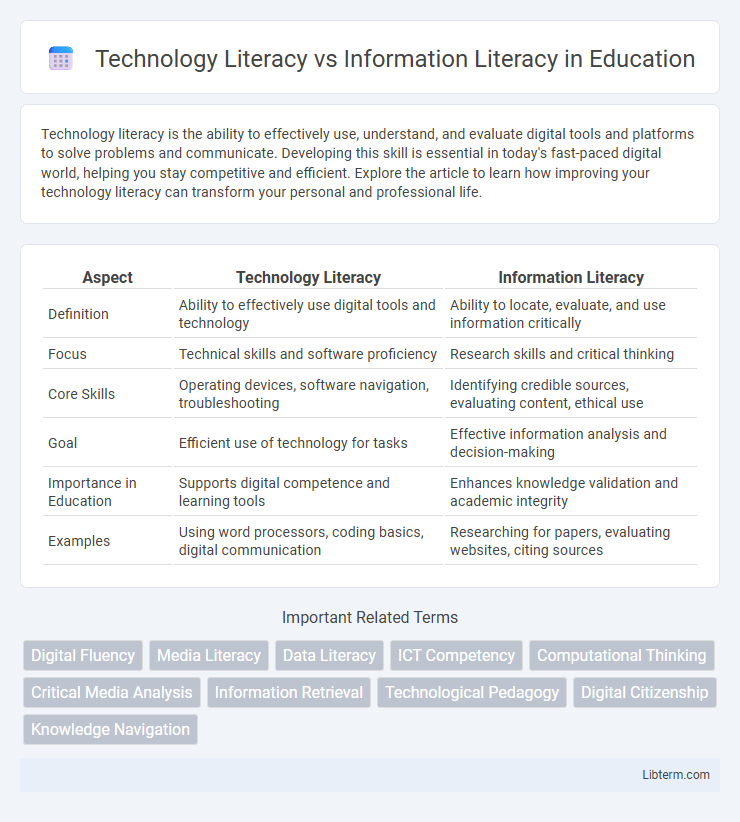Technology literacy is the ability to effectively use, understand, and evaluate digital tools and platforms to solve problems and communicate. Developing this skill is essential in today's fast-paced digital world, helping you stay competitive and efficient. Explore the article to learn how improving your technology literacy can transform your personal and professional life.
Table of Comparison
| Aspect | Technology Literacy | Information Literacy |
|---|---|---|
| Definition | Ability to effectively use digital tools and technology | Ability to locate, evaluate, and use information critically |
| Focus | Technical skills and software proficiency | Research skills and critical thinking |
| Core Skills | Operating devices, software navigation, troubleshooting | Identifying credible sources, evaluating content, ethical use |
| Goal | Efficient use of technology for tasks | Effective information analysis and decision-making |
| Importance in Education | Supports digital competence and learning tools | Enhances knowledge validation and academic integrity |
| Examples | Using word processors, coding basics, digital communication | Researching for papers, evaluating websites, citing sources |
Understanding Technology Literacy
Technology literacy encompasses the ability to effectively use, manage, and evaluate digital tools and devices, emphasizing practical skills in hardware, software, and digital platforms. It involves understanding the operational functions of technology, troubleshooting basic issues, and adapting to new technological innovations. Mastery of technology literacy enables individuals to leverage digital resources efficiently, fostering productivity and informed decision-making in various professional and personal contexts.
Defining Information Literacy
Information literacy involves the ability to locate, evaluate, and effectively use information from various sources, emphasizing critical thinking and data credibility assessment. It encompasses skills like understanding search strategies, recognizing bias, and distinguishing between reliable and unreliable information, which are essential in the digital age. Unlike technology literacy, which focuses on operating digital tools, information literacy centers on making informed decisions based on the quality and relevance of information.
Key Differences Between Technology Literacy and Information Literacy
Technology literacy emphasizes the ability to effectively use digital devices, software, and applications, focusing predominantly on technical skills and operational knowledge. Information literacy involves the ability to locate, evaluate, and critically analyze information from various sources to make informed decisions, highlighting cognitive skills and critical thinking. Key differences include technology literacy's focus on tool proficiency versus information literacy's emphasis on understanding and evaluating content quality and relevance.
Core Skills Involved in Technology Literacy
Technology literacy involves core skills such as understanding hardware and software functions, troubleshooting technical issues, and effectively using digital tools for communication and productivity. It requires proficiency in operating devices, navigating user interfaces, and applying cybersecurity practices to protect information. These skills enable individuals to adapt to rapidly evolving technologies and leverage digital resources efficiently in various contexts.
Essential Competencies of Information Literacy
Essential competencies of information literacy include the ability to locate, evaluate, and effectively use information from diverse sources to solve problems and make informed decisions. Technology literacy emphasizes proficiency with digital tools and platforms necessary for accessing and managing data, while information literacy centers on critical thinking skills to assess the credibility and relevance of information. Mastery of information literacy enables individuals to navigate vast digital content, distinguishing between accurate information and misinformation in an increasingly complex technological environment.
The Role of Technology in Modern Education
Technology literacy enables students to effectively utilize digital tools, software, and devices, fostering skills necessary for navigating modern educational environments. Information literacy complements this by teaching critical evaluation and ethical use of digital content, ensuring students discern credible sources and manage data responsibly. Integrating both literacies enhances learning outcomes, preparing students for future academic and professional challenges in a technology-driven world.
The Importance of Critical Thinking in Information Evaluation
Technology literacy equips individuals with the skills to use digital tools effectively, while information literacy emphasizes the ability to locate, evaluate, and use information critically. Critical thinking in information evaluation is crucial for discerning credible sources, analyzing biases, and avoiding misinformation in an age dominated by digital content. Mastery of both literacies ensures informed decision-making and enhances the capacity to navigate complex information ecosystems confidently.
Challenges in Achieving Technology Literacy
Challenges in achieving technology literacy include rapidly evolving digital tools that require continuous learning and adaptation. Limited access to reliable internet and modern devices creates disparities in skill acquisition across different socio-economic groups. Furthermore, insufficient training programs and lack of digital confidence hinder individuals from fully developing essential technology competencies.
Overcoming Barriers to Information Literacy
Overcoming barriers to information literacy requires addressing limited access to digital resources and enhancing skills in evaluating credible sources. Technology literacy supports this by enabling individuals to effectively navigate and utilize digital tools, while information literacy focuses on critical thinking to assess and interpret data accurately. Empowering users through targeted education and inclusive technologies bridges gaps, fostering both digital competence and informed decision-making.
Integrating Technology and Information Literacies for Lifelong Learning
Integrating technology literacy and information literacy is essential for fostering lifelong learning in the digital age, as it empowers individuals to efficiently access, evaluate, and create information using diverse technological tools. Mastery of digital platforms, critical thinking, and effective information management enables learners to adapt to rapidly evolving knowledge environments and maintain continuous personal and professional development. Educational frameworks that blend these literacies produce versatile learners who navigate complex information ecosystems with agility and confidence.
Technology Literacy Infographic

 libterm.com
libterm.com